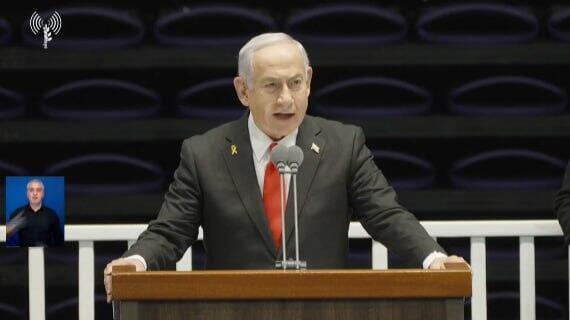Getting your Trinity Audio player ready...
Prime Minister Benjamin Netanyahu said Sunday that IDF troops would remain stationed in key areas of Syria and Lebanon, emphasizing that Israel demands the full demilitarization of southern Syria and will not tolerate any threat to the Druze community in the region.
Speaking at a ceremony for graduates of the IDF’s combat officer course, Netanyahu stated: “In Syria, IDF forces will remain in the Mount Hermon area and the buffer zone for an indefinite period to protect our communities and counter any threats. We will not allow forces from HTS (Hayat Tahrir al-Sham, led by Syria’s new ruler Abu Mohammad al-Julani) or the New Syrian Army to enter areas south of Damascus.”
Regarding Lebanon, Netanyahu declared that Israeli forces would maintain control over strategic areas along the northern border inside Lebanese territory until the Lebanese government and military fully uphold their commitments under the cease-fire agreement.
Defense Minister Israel Katz reinforced Netanyahu’s message, stating: “Our eyes are on the entire region today, especially Syria. We are committed to ensuring that October 7 never happens again. As the prime minister said, there is a new reality in southern Syria. The IDF will not allow hostile forces to establish a presence in the security zone from here to Damascus, and we will act against any threat.”
Katz also highlighted Israel’s commitment to strengthening ties with friendly populations in the region, particularly the Druze, whom he called “brothers in arms.” He reassured that Israel is dedicated to ensuring their safety and preserving their historical connections.
IDF deployments in Syria and Lebanon
The IDF entered the Syrian buffer zone immediately after the fall of Bashar Assad’s regime. At the time, the military cited concerns about armed groups moving into the area and deployed forces to key positions to protect Israeli communities in the Golan Heights. The IDF stressed that it does not interfere in Syrian affairs but will continue operating as necessary to secure the buffer zone and safeguard Israel.
Get the Ynetnews app on your smartphone: Google Play: https://bit.ly/4eJ37pE | Apple App Store: https://bit.ly/3ZL7iNv
After the Syrian rebels took control of the Golan and toppled Assad, the IDF warned them not to cross the Alpha Line, marking the start of the demilitarized zone. The Northern Command raised its alert level and activated emergency defense plans in anticipation of a potential invasion from the east.
In Lebanon, nearly six months after the start of what has effectively become the Third Lebanon War, Israel is reinstating a partial military presence inside Lebanese territory for the first time in 25 years. Under this new deployment, five outposts will be established just a few hundred meters beyond the border fence, each manned by hundreds of soldiers. The IDF plans to maintain this presence until a new political directive is issued.
The outposts, located outside Shiite villages near the border, will provide Israel with strategic control over previously vulnerable terrain. They include:
- A ridge overlooking the town of Shlomi to monitor infiltration routes from Wadi Qatia and observe Lebanese positions to the north and west.
- Jabal Balat, formerly known as Karakum outpost, to protect Shetula and Zar’it while overseeing the village of Zibqin.
- A position on Shaked Ridge, overlooking Avivim and Malkia, to monitor the Saluki River valley and the towns of Aitaroun, Bint Jbeil and Maroun al-Ras.
- An outpost on Tzivoni Ridge above Kibbutz Margaliot in the Upper Galilee.
- The northeastern-most outpost on Hamamis Ridge near the French Fort, securing the Ayoun Valley and Metula while overseeing the towns of Khiam and Kila.
A similar forward defense strategy is being implemented along the Gaza border, with ongoing coordination between the Southern and Northern Commands to apply lessons from recent operations.



